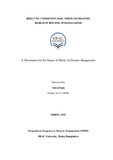Reducing community risk through disaster resilient housing in Bangladesh
Abstract
Bangladesh is a multi-hazardous and disaster prone country due to its geographic location and socio-economic condition of the people. Every year natural disasters disrupt the lives of people in some parts of the country. The housing sector is mostly damaged due to disasters on a regular basis and is the cause of most economic losses of the country. Houses and settlements are facing greater challenges triggered by natural hazards and uncontrolled urbanization in Bangladesh. Till date, there seems to be a lack of overall housing solutions for building of resilient rural structures that address future disaster risks posed to housing in the hazard exposed areas. Inappropriate housing solutions together with poorly constructed houses are considered as one of the main sources of risks to disasters.
Hazards in nature do not constitute disaster risk, however, the underlying vulnerabilities to hazards and external drivers construct disaster risk and resulting losses. These vulnerability factors are not addressed. The housing sector of the country tends to focus more on the physical improvements with limited attention to other aspects such as the social and administrative issues. From literature review in the context of Bangladesh, five significant findings have been considered that would ensure a resilient housing system; (i) local knowledge and construction practice to develop long term disaster resilient housing, (ii) improving local awareness and supporting local economy to raise resilience, (iii) improving communication between the local masons and the professional expertise, (iv) application of planning codes and construction regulation and (v) enhancing the local governance. This paper addresses such factors that may generate several policy implications for local authority to issue appropriate legal frameworks and supportive programs in order to improve local construction and to build safer and more resilient communities. Furthermore, it also addresses some approaches that may be crucial for disaster risk reduction which can be achieved through appropriate housing practices in Bangladesh.

